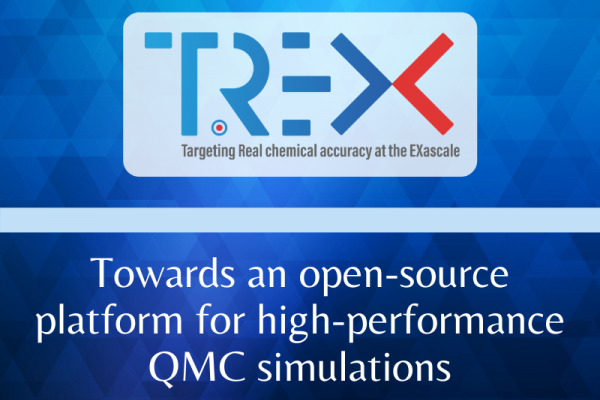Towards an open-source platform for high-performance QMC simulations. TREX first 8 months achievements

TREX libraries, codes and software eight months ahead
June 2021
TREX, the European Center of Excellence in exascale computing, is focusing on the development and application of quantum mechanical simulations in the framework of quantum Monte Carlo (QMC) methods. Eight months since its start, on 1st October 2020, the project has advanced towards the development of its open-source and high-performance software platform which will integrate TREX community codes QMC: TurboRVB, QMC=CHEM, CHAMP, and NECI; quantum chemistry: GammCor and Quantum Package; machine learning: QML in an inter-operable manner.
TREX objectives will be achieved by:
- Building two libraries: TREXIO, an I/O library in C for exchanging information among codes and a QMC kernel library (QMCkl) for high-performance QMC simulations.
- Modernizing TREX codes and refactoring them to make use of these libraries, and integrating them in AiiDa for workload management and HTC.
TREX Quantum Monte Carlo (QMC) flagship codes
At the centre of the TREX offer, there are the TREX quantum Monte Carlo (QMC) flagship codes, offered to the TREX stakeholders as a unique possibility to compute high-accuracy properties for very large or extended systems, where other accurate quantum chemical approaches are often very difficult to apply. During these first eight months, most of the TREX codes (CHAMP, TurboRVB, NECI, and GammCor) have been profiled with the MAQAO profiling tools. Bottlenecks have been identified and modification of the codes has started with sizeable performance improvements:
- GammCor: 20% speedup on single core;
- CHAMP: 25% speedup on single core.
In this same period, the flagship code TurboRVB has been further optimized during a GPU Hackathon organized by JCS. The code can now run using the NVIDIA HPC compiler on many different platforms (x86, POWER, and Arm) and it’s ready to run on the upcoming Leonardo pre-exascale supercomputer. The gain with respect to the CPU version is so far a factor of 8x but further optimizations are possible. A user-friendly Fortran-based parser has also been designed to parse the input files of multiple flagship TREX codes. This implementation can handle multiple data types and file formats. The TREX parser is based on the libfdf library developed within the E-CAM CoE.
|
About TurboRVB. TurboRVB is a computational package for ab initio Quantum Monte Carlo (QMC) simulations of both molecular and bulk electronic systems. The code implements two types of well established QMC algorithms: Variational Monte Carlo (VMC), and Diffusion Monte Carlo in its robust and efficient lattice regularized variant. About CHAMP. CHAMP enables the very efficient wave function optimization for ground and excited states, a compact formulation for a fast evaluation of multi determinant expansions and their derivatives, and multiscale schemes to perform QMC calculations in classical point charges, polarizable continuum model, and polarizable force fields. About QMC=Chem. QMC=Chem is the QMC code developed by the CNRS/Toulouse group. It is particularly well adapted to very large multi-determinant expansions and was optimized for the x86 architecture in close collaboration with the HPC experts of the UVSQ partner laboratory. It is designed to be used on HPC resources as well as grid/cloud infrastructures. About NECI. NECI is developed in the Alavi group (MPG) under a GNU GPLv3. It performs stochastic FCIQMC simulations of quantum chemical Hamiltonians in 2nd quantised representations, aiming at FCI accuracy for the energy and wave function. About QuantumPackage. QuantumPackage is an open-source program to obtain near-FCI-quality wave functions, energies, and one- and two-electron reduced density matrices for ground and excited states with a stochastic variant of a selected-CI (CIPSI) algorithm. About GammCor. GammCor is developed in the group of Pernal (TUL) and performs calculations of interaction energy using multireference symmetry adapted perturbation theory method (for ground and excited states), the adiabatic connection (AC and AC0) correlation energy for ground- and excited-state multireference wave functions, range-separated multiconfiguration DFT energy with the long-range |
The optimization of the TREX QMCkl kernel library has started
To efficiently use an exascale machine, the possibility to run simultaneously multiple inter-dependent large-scale calculations must be considered. This requires the codes to be interfaced with a high-quality I/O library. The I/O performance needs to be high, and the library should also make sure that the files are not corrupted if a system failure happens or if a program fails. Designing a fast and robust I/O library is a challenge.
In April, the alpha-version of the I/O library for handling communication between TREX flagship codes was released. The I/O library has a developer-friendly front-end interface and can handle various types of files (text and HDF5 binary formats) as a back end. The current release focuses on handling large files containing all the information required to evaluate the many-body wave function. The consortium is now entering the testing phase.
Get ready for the TREX, SISSA & Psi-k Summer School
Quantum Monte Carlo (QMC) methods belong to one of the most accurate families of numerical approaches for materials and electronic structure calculations. Moreover, the steady increase of computer power in HPC machines is very much suitable for the development and usage of stochastic ab initio methods, which - beside the high precision - are highly parallelizable and enjoy a favorable scaling with the system size. However, the number of QMC codes is still limited as well as the size of the community. It is therefore of paramount importance to disseminate the knowledge, information, and practice of this kind of methods, particularly among students and young researchers.
During the summer 2021 from 12 to 16 July, the TREX project, the International School for Advanced Studies (SISSA, Italy) and the Psi-K network organise an e-School as a virtual event, where students will be using TurboRVB code for QMC applications and tutorials. The TREX e-School on Quantum Monte Carlo with TurboRVB represents a unique opportunity to provide a comprehensive introduction to QMC methods without any prerequisite. Registration is open until July, 5th.


